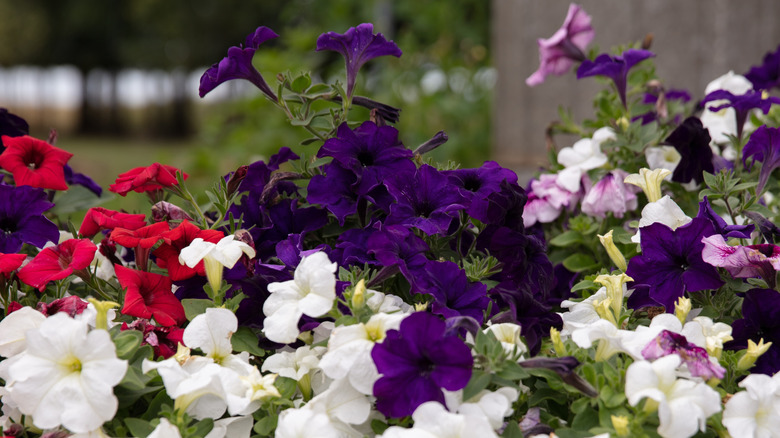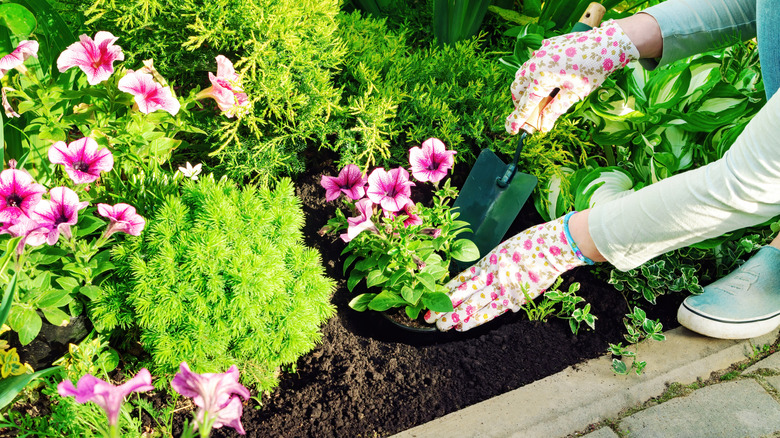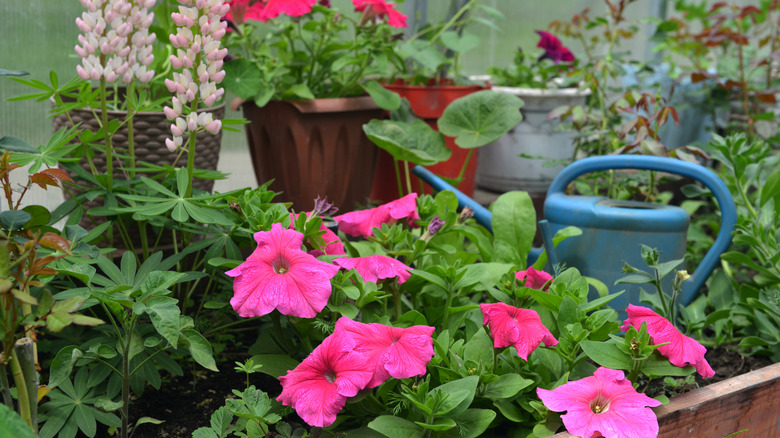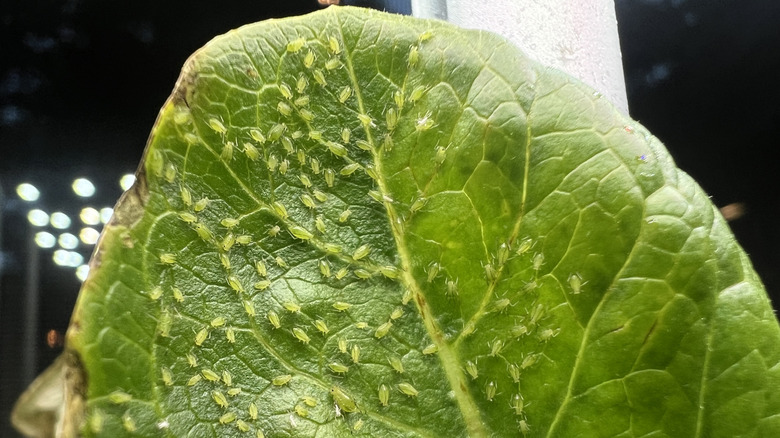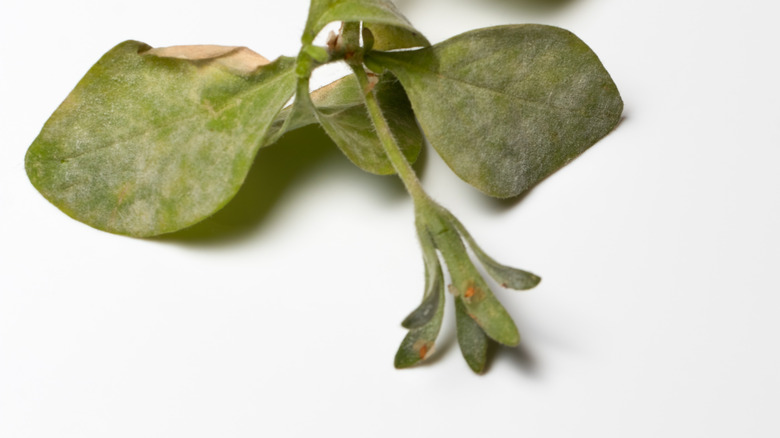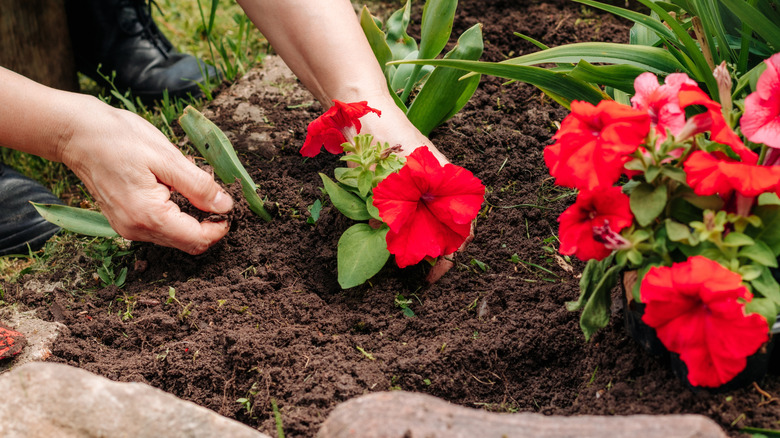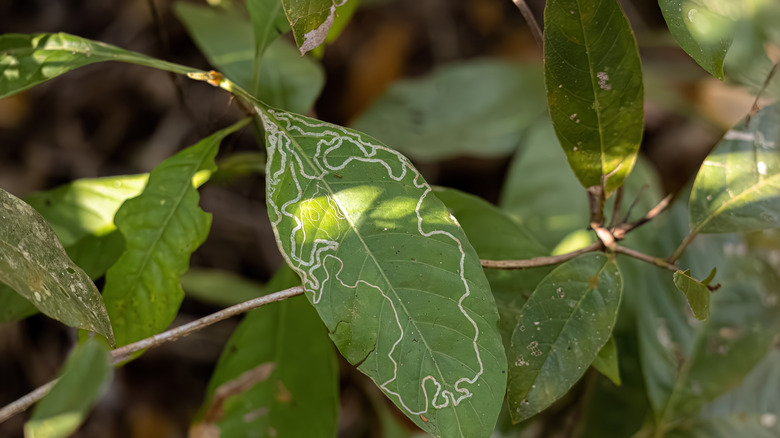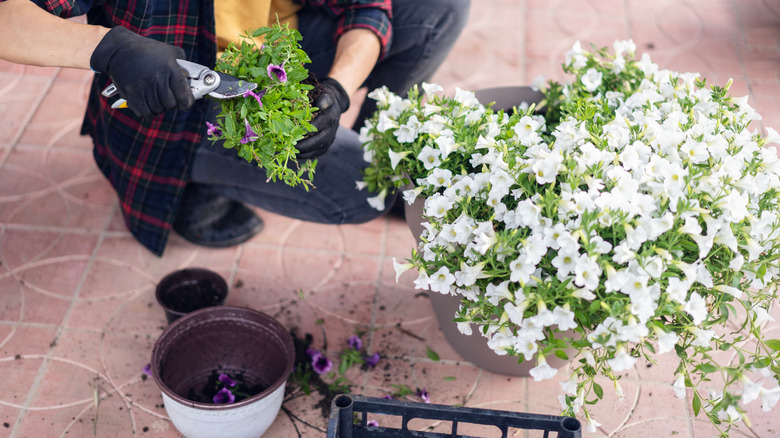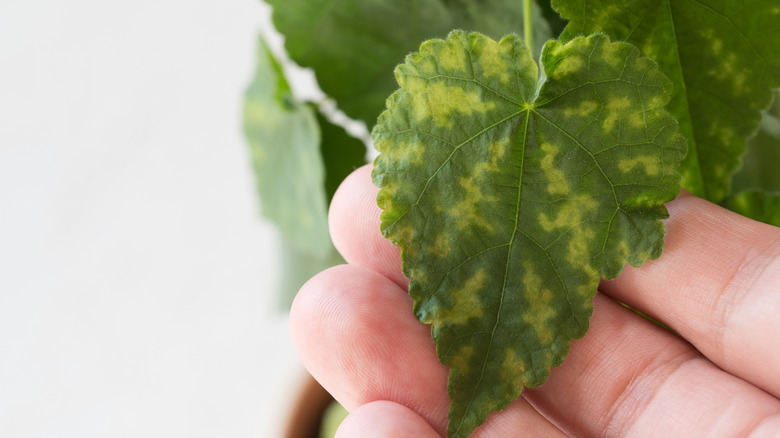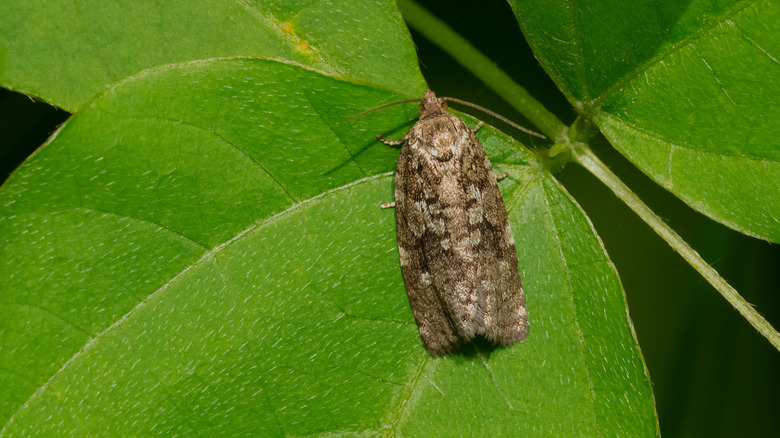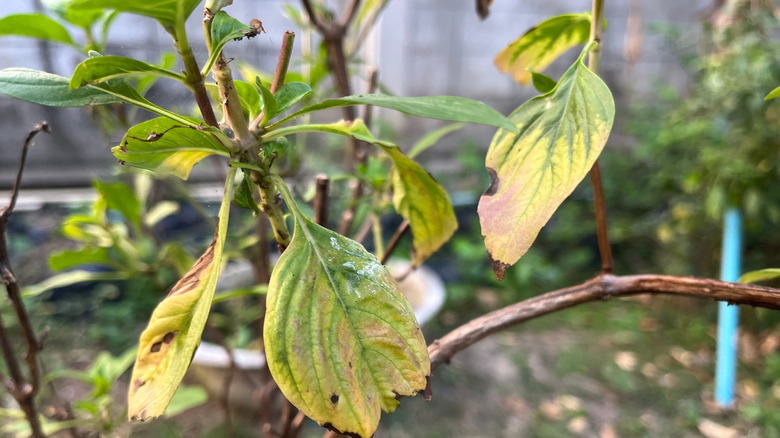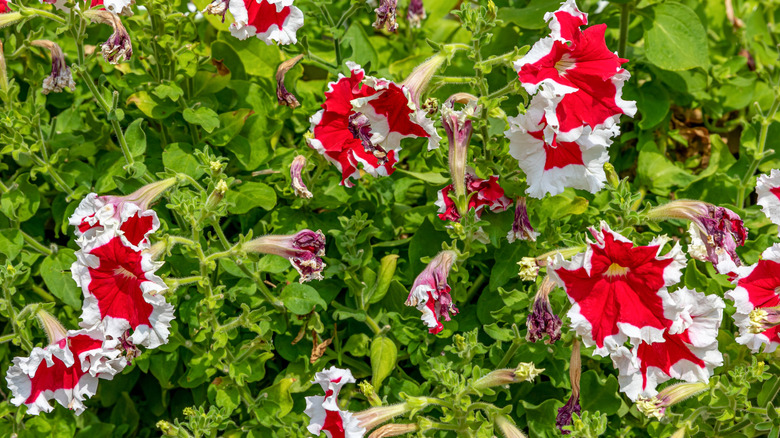Common Petunia Problems To Know About Before Growing Them In Your Backyard
If you want flowering annual plants that are dependable and easy to grow, petunias (Petunia spp.) may be just what you're looking for. As one of the most popular types of backyard plants, they're arguably perfect for novice gardeners. Petunias are generally hardy, and they can withstand changes in temperatures. While there are some size variations among the hundreds of types of known petunia varieties, most produce flowers that will likely bloom throughout the spring and summer months. Some may also last into fall, depending on when temperatures drop below freezing in your area.
The caveat to their ability to thrive, though, is knowing how to prevent and treat some of the most common petunia problems that may develop in these popular plants. Like all other plants, petunias may be susceptible to certain diseases and pests, and they still need the right amount of water and sun in order to thrive. It's best to be aware of these issues before you grow petunias in your backyard. However, if you do have petunias and they aren't thriving as they ought to, you can also check to see if they are struggling with some of the more common problems.
Too much shade can cause issues with petunias
Petunias are known for their ability to grow in a variety of conditions. However, if you're noticing a lack of flowers in the spring or summer, you might consider whether your petunia plants are getting enough sunlight. This problem may be even more noticeable if you have some petunia plants in shady areas with few flowers, but plants in other parts of your backyard that get sunlight have more flowers. The good news is that this problem is relatively easy to prevent.
For the best results, plant petunias in an area of your backyard where they can get full sun. Ideally, this should be a minimum of five hours per day, but the more sun a petunia plant can receive, the better. Another option can be to move planter-grown petunias around your yard in order to maximize sun exposure. Spindly stems are another key sign your petunias need more sun.
Petunias can wilt when overwatered
Petunias are considered a favorite plant for gardeners in hotter environments because of their reputation for withstanding heat. Still, while all petunias need water, most varieties require little of it. In fact, watering them too often can lead to certain petunia diseases, and even cause them to not grow properly. If you notice your petunia plants are wilting, or if they have leggy stems with few leaves, there's a good chance you may be overwatering them.
As a rule of thumb, consider watering your petunias just once per week. You may be able to get away with even fewer watering sessions during rainy seasons. Watering frequency also varies between types of petunias. In particular, "spreading" petunia types and those grown in containers require more water than other varieties. Also, if you have newly planted petunias, aim for providing them with up to two inches of water every week until they are established.
Aphids are common petunia pests
Petunias are generally known for not being particularly vulnerable to serious pest infestations, which is another reason why they are popular plants in gardens and backyards. However, there are a few pests you do need to be aware of. Aphids are among the most notable pests that can damage petunias. These small insects can suck on the leaves of your petunia plants, resulting in yellow leaves and unhealthy-looking flowers.
It's not hard to identify signs of aphids, and if you see these small pear-shaped insects on your petunias, it's important to get rid of them immediately. First, you can try spraying them off the affected plants with a high-pressure garden hose. Then, follow up with an insecticidal soap to address remaining aphids. Another method is to grow nectar-containing plants near your petunias. These might encourage aphids' natural predators to stop by, such as ladybugs and wasps, which may help control aphid populations more naturally.
Petunias are sensitive to excess ethylene
If you feel like you've taken all the right steps in planting petunias but are starting to see sudden flower losses, curled leaves, or stunted growth, you might consider possible ethylene contamination. Ethylene itself is a type of hormone often used in greenhouse settings. It usually promotes healthy growth, so that greenhouse farmers can easily grow a large number of plants. The problem is that these environments can also lead to excess ethylene exposure, usually due to inadequate ventilation. Petunias are among some of the most common plants affected, along with begonias, geraniums, orchids, and fuchsias.
Greenhouse-ethylene isn't a direct problem when you're growing petunias in your backyard. However, you may want to take steps to ensure your plants weren't previously exposed to excess ethylene beforehand. If you're buying potted petunias from a garden center, steer clear of those that show signs of recent flower losses or deformed leaves. You may also consider growing petunias from seed instead if you cannot find healthy-looking petunias at your local garden center.
A variety of fungal diseases can affect petunias
Petunias that develop white or gray spots, areas of fuzzy texture, or brown leaves may also be possible signs of a fungal disease. While these symptoms are most common during final flowering stages before the flowers wilt and fall off, fungal diseases can technically develop at any time. This is especially the case in the summer months, or at any point where the climate is humid. Some of the most common fungal diseases in petunias include powdery mildew, verticillium wilt, and botrytis cinera.
While you can't control the weather and resulting conditions that may increase the risk of fungal diseases in your petunias, you can take steps to help reduce its spread. First, you can make sure petunias aren't planted too close to one another to help promote air circulation between them. Avoid watering any flowers directly, and remove any spots on the plants with possible fungus to prevent its spread. You may also consider applying a commercial fungicide as a last resort.
Petunias may also be affected by crown or root rot
Unfortunately, all flowering plants are susceptible to pathogens that attack their crowns and roots. Petunias are no exception here. Also called crown rot or root rot, these fungal and bacterial diseases can develop either underneath or above the ground. Some of the first symptoms of these diseases include wilting or dull-colored leaves. They may then eventually turn yellow.
Crown and root rot diseases can spread quickly, and even some types can destroy multiple petunias within less than a month. You can help prevent these diseases by giving petunias space between plants, and also watering them in moderation at the ground only. Well-draining soil can also help prevent the development of crown and root rot. If you do see signs of these diseases in your petunias, however, it's best to remove the affected plants immediately to avoid their spread to healthy plants.
Leafminers can damage petunia leaves
If you're noticing white-colored lines and irregular-shaped splotches on the leaves of your petunia plants, you may be dealing with leafminers. As their name suggests, leafminers create mines into leaves in order to eat. These insects are types of flies that also lay their eggs among the leaves they eat from. Once the eggs hatch, the resulting maggots also feed on plant leaves, doing even more damage.
While leafminers, their eggs, and the damage they create are all unsightly, the good news is they don't usually kill the plants they target. The bad news is the insects are a bit difficult to get rid of. There are, however, a few options you can try to minimize damage to your petunias and keep the leafminers from quickly reproducing. First, you should check the undersides of plant leaves for any signs of eggs and maggots. You can clip any infested leaves to help control the leafminer population and help spare the rest of your petunias. Another option is to plant pollen-producing flowers nearby to encourage parasitic wasps as a means of deterring adult leafminers. Pesticides should be used as a last-resort because they can harm natural predators such as wasps, and they only get rid of adult leafminers while leaving their eggs unharmed.
Petunias require regular pruning to stay healthy
Petunias generally don't require too much maintenance, and when conditions are right, they can thrive into colorful flowering plants in your backyard area. However, to keep them healthy, you might need to prune your petunias once in a while. This helps to ensure petunias continue to flower throughout the spring and summer. It also keeps the plants at a manageable size, particularly if your petunias are in planters or raised beds.
To prune petunia plants, take a small pair of gardening scissors and trim branches back to their nodes. These are located between leaves and stems, and when trimmed regularly, you can help encourage new flower growth. You can either trim all branches at once, or a little bit at a time. Keep in mind that pruning all at once can cause you to temporarily have flower-less petunias until they produce new blooms within a couple of weeks. Another option is to develop a habit of pinching off dead flowers and stems throughout the season to encourage new flower growth.
Nutritional deficiencies can lead to interveinal chlorosis in petunias
Petunias do well with full sun and not too much water, and they can even grow in less-than-ideal soil. Still, a lack of nutrients in the soil can eventually cause problems with these plants. This may lead to interveinal chlorosis, a type of nutritional deficiency that is common in home gardens. Interveinal chlorosis can develop from a lack of iron, magnesium, molybdenum, and manganese, which can disrupt the process of photosynthesis in your plants. Over time, you may notice yellowing leaves but with green veins, from low chlorophyll levels.
If you're seeing possible signs of interveinal chlorosis on the leaves of your petunias, consider adding acidity to the soil with the help of a sulfur-containing fertilizer or plant food. You can also test the pH of the soil. Ideally, this should be 5.4 to 6.0 around the roots of the plants. A pH that is higher than 6.0 could indicate a lack of nutrients that could increase the risk of interveinal chlorosis development. As a rule of thumb, consider testing the soil once per week so you can identify possible nutritional deficiencies before they become problematic.
Budworms and slugs may feed on petunias
It's not common for serious pest issues to develop in petunias. However, sometimes budworms and slugs can become problematic in these popular plants. Petunia budworms are perhaps the most common of these. Also called geranium budworms, these small creatures are actually gray moth caterpillars that have recently hatched from eggs. They tend to feast on the leaves and flowers, and may sometimes lay eggs around their feeding areas. If you see small holes in your petunias, these are telltale signs of this issue.
The best way to control petunia budworms is to remove their small brown eggs from the plants. This prevents them from hatching and creating subsequent budworm feasts. You may also consider using an insecticide during the dusk hours, when budworms tend to be most active around the plants. If you notice slugs around your petunias, place baits near their vicinity to help control them.
Thrip infestations can quickly damage petunias
If you're starting to see silver-colored spots among your petunias with tiny, narrow bugs, you could have a thrip infestation to get rid of. These can become quite damaging to petunia plants because of the way the insects feed from them. Thrips like to feast on the leaves, literally sucking out mesophyll from them. Ultimately, this can lead to permanent damage in the form of white scars, and even cause petunia plants to die prematurely.
The best way to prevent thrip-related damage from petunias is to regularly monitor your plants for infestations. Not only are silvery patches and white scars indicative of thrips, but you may also see these tiny brown-colored, oblong-shaped bugs with the naked eye. If you do see signs of thrips, you can gently shake them off from petunia plants or prune off affected areas. You can also trap adult thrips with sticky strips nearby, or use insecticides on your petunias as a last resort.
Viruses may occasionally affect petunia plants
Several fungal diseases can affect petunias, particularly when they get too much water and not enough sun and air flow. The possibility of viruses should also be considered. Among the most common of these include petunia mosaic, beet curly top, tomato spotted wilt, and impatiens necrotic viruses. Possible signs of a virus affecting your petunias include spots, stunted growth, and unusual looking flowers. Some of these viruses may also be transmitted via pests, such as thrips.
Unfortunately, viral diseases can greatly impact the appearance of petunias and other plants, and it can also get to a point where the affected plant must be dug up. Digging up impacted petunias can also help prevent the diseases from spreading to other plants. Before you get to this point though, consider implementing measures that may help prevent viruses in your petunias. Pest management and regular weeding to prevent insects from accessing petunias can help, along with monitoring for signs of unwanted bugs.
Mites can hide in petunias and cause a lot of damage
Mites are another challenging problem in petunia plants. These microscopic arachnids measure just 0.02 mm long, and can hide among the leaves of your petunias while they feast on chlorophyll. The most notorious of all the mites that affect petunias are cyclamen mites, due to a toxin they emit from their saliva. While you might not to see the mites with the naked eye, some signs of a cyclamen mite infestation include twisty leaves and reduced flowering.
Cyclamen mites are difficult to kill with conventional methods like pesticides, due to their size and ability to hide deep within petunia leaves. There are a few steps you can take to protect your petunias from mite damage, though. One method is to dip the plants in warm water, as the hot temperatures are thought to kill the mites without harming petunias. For best results, you may consider cutting off damaged leaves before dipping the entire plant in the water. If some of your petunias have extensive damage, it may be best to get rid of them before the mites spread to healthy plants.
